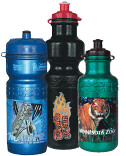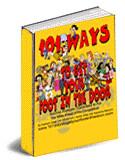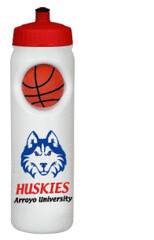You've been knocking on the door of this important potential customer for over a year. You have established yourself as #2. If the other guy slips up or can't do it, you get the next call. Today is your day. They need 300 water bottles by Friday, 4 color process. The other guy had the order, but it can't be delivered by the deadline. You know that this is your chance to become #1. How much control do you have over your own destiny?
According to David Blaise's "
Top Secrets of Promotional Products Sales," 85% of the quality of your customer service depends on the customer service of your supplier. To be honest, if I were in your business, I would not like those odds. So, how can you increase your control over your own failure or success?
Two strategies stand out. By far the most important element is Supplier Selection. The second and still hugely important element is not overpromising. Let's visit these two, one at a time.
If you have been in the Promotional Products Biz for any length of time, you have had to deal with a missed event, many near misses, and more than a few dozen nerve-frazzling might-have-been missed deadlines. Even those promotions that go off perfectly may often be plagued with uncertainty between placement of the order and delivery due to art, documentation, raw material shortages, imprint problems ... I better stop before I make you depressed.
As a supplier it takes a real big set of nerves to say this, but if a supplier messes you up or gives you heartburn, whose fault is it really? There are plenty of resources and methods available to determine the capabilities and track record of potential suppliers. If you blindly select a supplier because they are the only one you can find for a certain product, or the only one that can hit your price point, you are setting yourself up for disaster.
Referring to David Blaise again (
Top Secrets of Promotional Product Sales), he maintains that you should test every new supplier by calling and asking for samples. How is the phone response? Do samples arrive when promised? Do they arrive at all? How do the samples look? Even if everything goes well, was there any part of the experience that showed potential for doing even more than was asked for? Did the customer service person attempt to learn more about your use, so that they could recommend other options? Did they explain color choices, advise regarding stocking or timing issues, or discuss art possibilities?
You should, if you or your company doesn't already do so, create a database of suppliers. No, not just a wall of catalogs or reliance on ESP or SAGE. This database should have suppliers you have used rated by some kind of code. Many of our best customers use us exclusively for sports bottles. They don't even look at our competitors. We are highly rated based on prior performance. Why risk using another supplier?
Do we ever mess up? Sure. But it is our philosophy that when we do, we will do whatever is necessary to make it up. We have had an employee drive 400 miles to make a Saturday morning delivery. We have overnighted product at our expense to England. You need to have 100 or more suppliers who you know will always get it done, and done right.
Your customer calls and wants a dispenser of hand soap with their name on it. And they want it in two weeks. You have no one in your database of preferred suppliers who offers hand soap in dispensers. What are your options?
As suggested earlier, my first step would be to ask all about the project. Demographic, strategic plan, reasons for short window, budget, etc. Half of my reason is to boost my image with the customer by being a professional marketing assistant. The other half is to create the maximum number of options for serving him.
Checking all my normal resources, I determine that there are a couple of companies in the industry that can meet the need. Neither my company nor anyone I know has ever purchased through them before. I check ESP and SAGE with mixed results on their performance history. I call both and ask for samples and pricing. One company is adequate, the other sloppy. Both say they can meet my deadline.
I would go back to my customer and explain the exact truth. I have located an adequate supplier. I have no experience with that supplier, but they say they can make the date. I explain where the ratings come from and how I reached my conclusion. Then I suggest alternative solutions that would use companies I know can hit the date. If the customer decides to go forward with the project have I shifted some of the responsibility to him? Not at all. To the extent that I take the order, I am still on the hook. Any failure to deliver on time will certainly be laid at my feet.
If I take the order, I will now follow it very closely, leaving nothing to chance. I will ask for commitments for each stage of the process. When will art files be faxed? When will labels be finished? What day will product be shipped? What is the backup plan if something goes wrong?
Then I will establish my own back up plan. In our discussions, what product would the customer most likely accept in an emergency? Make sure that the backup supplier is in a position to take a rush order.






